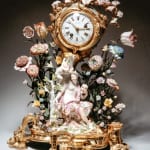


Ormolu mounted Clock, Circa 1750
Width: 14½ in (37.5 cm)
Depth: 11½ in (29 cm)
Further images
An extremely rare and important ormolu-mounted porcelain clock. The clock manufactured and signed by Julien le Roy, clockmaker to Louis XV.
The clock with a seven-day movement striking on both the hour and half hour, is cased in Chinese celadon porcelain.
The central porcelain figure group in Meissen hard-paste porcelain is modelled by J.J. Kaendler c. 1750, and represents Thalia the Muse of Comedy. Thalia holding a mask in her left hand and a writing implement in her right. Two other comedy masks lie on the ground by her feet. Cupid smiles down at her from the branches of a tree, with a monkey seated at her side taking snuff.
The porcelain group surrounded by finely modelled soft-paste porcelain flowers from the Vincennes factory, attached to green-laquered metal stems and leaves.
The whole work supported by an intricate ormolu creation inspired by the formal Royal Gardens of Vincennes and Fontainebleau and cast in the Paris workshop of a marchand-mercier who assembled this masterpiece.
Crossed swords marks to base.
“Thalia” incised on the base of the porcelain tree.
“Julien le Roy, Paris” incised and signed on the internal working of the clock.
Join our mailing list
* denotes required fields
We will process the personal data you have supplied in accordance with our privacy policy (available on request). You can unsubscribe or change your preferences at any time by clicking the link in our emails.


